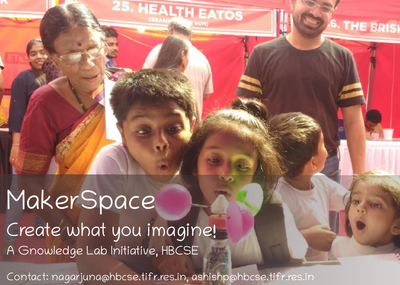Maker Space
A Gnowledge Lab Initiative

Introduction
The MakerSpace at HBCSE focuses on Do-it-Yourself (DIY), free and open source (FOSS) scientific instruments, hardware or anything that involves making, tinkering and engineering for research and educational purposes. Such activities are designed to help students and teachers develop ideation, design thinking, parametric thinking, computational thinking and physical computing abilities. The new media technologies and rapid prototyping tools such as laser cutters, 3D printing, Arduino, and Raspberry Pi have revolutionized the maker movement and empowered people to bring their ideas to life. At our MakerSpace we organize workshops and short courses for both teachers and students across India to get them excited about STEAM education while nurturing their inherent creativity and curiosity.
A few of the highlights of the our MakerSpace:
1. Instruino
2. Hard Disk Centrifuge
3. DIY Gaming Station
4. Hydroponics
5. DIY Weather Station
6. DIY Spectrophotometer
7. DIY web-camera based microscope
1. Instruino

Instruino is a cost effective DIY FOSS Portable Lab Device developed using the Arduino Mega to measure the parameters such as humidity, ambient temperature and of liquid, pH value, turbidity and light intensity. It is developed for the biology lab where it has important role in conducting experiments and research. The device features the data visualization (on graphs and other widgets) over the internet, connected via its wifi. It also allows the data to get logged into the SD card along with timestamp and also sends the data to be viewed on smartphones via bluetooth. It also features the audio-visual alarm against the threshold set by the user. It can be easily replicated, modified and used by the researchers and students.
2. Hard Disk Centrifuge

Hard Disk based Centrifuge is a relatively low cost FOSS centrifuge made from scrap hard disk (an e-waste) for DIY biolabs where budget is the main concern. A centrifuge is device which uses the centrifugal forces for separating the different materials suspended in the liquid. As this scrap hard disk are cheaply and easily avialble and also its motor meet the high RPM requirements for the centrifuge. This motor is a brushless DC motor thus requires special drivers to make it run, electronic speed control (ESC) is used here as a driver and pulse width modulation (PWM) signal is generated from Arduino Nano board to vary the speed of motor from 0 rpm to its maximum rpm (which is usually up to 7200 rpm). A potentiometer is used here to map the PWM signal. The hard disk body itself is used as a base for the centrifuge, the acrylic disc with tube holder is mounted on the motor.
3. DIY Gaming Station

DIY gaming station is an array of neopixel LEDs which provides a canvas to design your own game. Currently, we have two games running on it. There is standalone remote as well as an app to play the game.
Tetris - In this game, there are seven different kinds of blocks which fall in random order. The task is to align them in such a way that a row is completely lit with LEDs. On completing the row, it vanishes and the players get one point. The game is over once the stacked up pieces reach the top of the matrix and there is no more place to make another block fall. The user has three control option - moving right, left and rotating the pieces. Snake - In this game, the tail of the snake grows by one unit on eating the food. The game gets over once the snakehead touches its own body. The food gets randomly generated and the playing ground is permeable ie. on reaching the top, the head generates from the bottom. The gaming station can enable one to pick up electronics, programming, and fundamentals of physics in an engaging and meaningful manner.
4. Hydroponics

Aeroponics is the process of growing plants in an air or mist environment without the use of soil or an aggregate medium. Here, we have used a PVC pipe to make slots where the plants can be kept. The water is raised up using the motor and then drips through the plants' roots. There is an inbuilt timer which makes the motor switch on and off in a cyclic period of a minute.
5. DIY Weather Station

Micro Weather Station is a cost-effective DIY FOSS weather station developed using the Arduino Mega to provide the weather parameters such as wind speed, wind direction, rainfall, atmospheric pressure, altitude, temperature, humidity, and light intensity. All these readings are visualized on the web UI powered by a FOSS IoT platform ThingsBoard hosted on our server. The data collected will be used to train the participants in data analysis, detecting patterns, plotting graphs, prediction etc. This project is designed to activate the various Atal tinkering labs that are set up all over the country in several schools and colleges. The participants will be encouraged to innovate on the design to make the instrument accurate and weatherproof.
Live Data: https://iot.metastudio.org/dashboards/0cd220a0-42ed-11e8-aa2e-8ff59179c3b5?publicId=3e443cf0-9fd5-11e8-9d11-f9889e96e775
6. DIY Spectrophotometer:

This box spectrophotometer uses diffraction grating and 3D printed parts to make the casing. There is a stepper motor which moves the setup for the scanning i.e passing different wavelengths via the cuvette. The fall in intensity is detected by a photodiode and the data is recorded. To make slits, simple blades are used.
More details: https://punkish.org/Spectrophotometer
7. Web Camera Based Digital Microscope